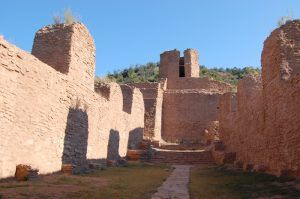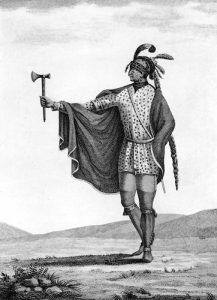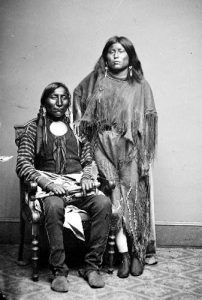Summary of Native American Tribes – J-K – Legends of America (original) (raw)
Summaries: A B C D E-I J-K L-M N O P Q-R S T-V W X-Z
Jemez State Monument – Gisewatowa Pueblo Church Ruins by Kathy Alexander.
Jemez – Pronounced “Hay-mess,” or traditionally as “He-mish,” the Jemez is a federally recognized American Indian tribe with 3,400 tribal members, most of whom reside in the pueblo village known as Walatowa, a Towa word meaning “this is the place.” Oral traditions say their ancestors originated from a place called “Hua-na-tota,” which is apparently identical to the Shipapu and Cibobe of other Pueblo tribes. They migrated to the “Canon de San Diego Region” from the four-corners area in the late 13th century. By the time of European contact in the year 1541, the Jemez Nation was one of the largest and most powerful of the Puebloan cultures, occupying numerous pueblo villages that were strategically located on the high mountain mesas and the canyons that surround the present Pueblo of Walatowa. Today, it is the last remaining Towa-speaking pueblo, having absorbed the Towa-speaking survivors of Pecos Pueblo when it was abandoned in the 1830s. The pueblo itself is closed to the public except during feast days. However, Walatowa, the main village, is open to the public. It is located on the north bank of Jemez River, about 20 miles northwest of Bernalillo, New Mexico. More information: Pueblo of Jemez-Walatowa Visitor Center, 7413 Hwy 4, P.O. Box 280, Jemez Pueblo, New Mexico 87024; 575-834-7235.
Kalapuya – The Kalapuya Family of Native Americans is a group of tribes formerly occupying the Willamette River Valley in northwest Oregon that spoke closely related languages. The Kalapuya people are believed to have entered their historical homeland in the Willamette Valley by migrating northwards from the south of the valley and forcing out earlier inhabitants. They seem to have confined themselves to this territory, except in the case of one tribe, the Yoncalla, which pushed southward to the valley of the Umpqua.
Kanza (Kaw) – A Siouan tribe closely related to the Omaha, Osage, Quapaw, and Ponca, the name “Kaw” or “Kanza” means “People of the South Wind,” and the state of Kansas takes its name from them. Their homeland was along the Kansas River, a Missouri River tributary extending from Kansas into Nebraska. Today, they hold a small land trust near the Osage in Oklahoma.
Karok – Indigenous people of California, their name means “Upstream,” defining them in relation to the Yurok, who lived “downstream” on the Klamath River from them. The Karok’s name for themselves is “Araar,” meaning “human being.” Traditionally, the Karok lived along the Klamath River in Humboldt and Siskiyou Counties in northwestern California and on the tributary Salmon River. The Karok had little contact with white settlers until gold miners arrived in 1850 and 1851, resulting in widespread disease, violence, social dislocation, and cultural breakdown. Today, some 4,000 people identify themselves as having a Karok heritage. Though the Karok have no reservation, their tribal headquarters are in Happy Camp, California.
Kaskaskia Indian.
Kaskaskia – One of several tribes that made up the Illiniwek Confederation, the Kaskaskia lived along the Illinois River near present-day Utica, Illinois. By the 1760s, the tribe had dramatically declined in numbers due to war with its French allies and new infectious diseases to which they had no immunity. Today, they are part of the Peoria tribe, with a reservation in Oklahoma.
Kennebec – The Kennebec tribe, also known as Norridgewock and Kennebis, were an early Abenaki band that lived in the Kennebec Valley of Maine. After years of war, the remnants of the Kennebec fled to Canada or merged into other Abenaki and New England Algonquian groups. Today, there is no distinct Kennebec band.
Keresan Family – Also called Keres, Queresan, and Queres, this is a group of seven related languages spoken by Keres Pueblo peoples in New Mexico. Each is mutually intelligible with its closest neighbors, but there is significant diversity between the Western and Eastern groups. This linguistic family of Pueblo Indians includes the inhabitants of several villages on the Rio Grande in north-central New Mexico.
Kickapoo – Before contact with Europeans, the Kickapoo lived in northwest Ohio and southern Michigan between Lake Erie and Lake Michigan. By common tradition, the Kickapoo and Shawnee believe they were once a single tribe but separated after an argument over a bear’s paw. When the white man pushed west, the Kickapoo migrated to Wisconsin, then Illinois. By treaty, they were relocated to southern Missouri.
Kiowa – Lone Wolf And Wife.
Kiowa – The Kiowa are a Native American tribe of the southern plains. Historically, they are known to have lived in the Kootenay Region of British Columbia, Canada, to have migrated to Western Montana, and then continued to move until they inhabited present-day Nebraska, Kansas, Oklahoma, and Texas. Allying themselves with the Comanche, the Kiowa carried out raids as far south as Mexico. Nomadic buffalo hunters, the Kiowa, were soon forced onto a reservation in Oklahoma, where the majority remained.
Klallam – Also called Clallam, they were a tribe of the coastal division of the Salishan linguistic stock and were most closely connected with the Songish. They lived on the south side of the Strait of Juan de Fuca, between Port Discovery and the Hoko River in Washington. Later, the Klallam occupied the Chimakum territory, and a small number lived on the lower end of Vancouver Island. Three bands continue to exist today, three of which live on the Olympic Peninsula in the far northwest corner of Washington state, and one is based at Becher Bay on southern Vancouver Island in British Columbia.
Klickitat – A Shahaptian tribe whose home was at the headwaters of the Cowlitz, Lewis, White Salmon, and Klickitat Rivers in Klickitat and Skamania Counties, Washington. In 1805, Lewis and Clark reported them as wintering on the Yakima and Klickitat Rivers, and they estimated their number to be about 700. Between 1820 and 1830, the tribes of Willamette Valley were visited by an epidemic of fever, and the number was significantly reduced. Enterprising traders became known as intermediaries between the coast tribes and those living east of the Cascade range. They joined the Yakima treaty at Camp Stevens, Washington, on June 9, 1855, by which they ceded their lands to the United States. Today, they reside with the Yakima Indians on the Yakama Reservation in Washington.
Kootenai – This nomadic tribe stretched west of the Rocky Mountains to Arrow Lake in British Columbia. The word Kootenai originated from a Blackfeet word meaning “slim people.” They are divided into eight bands: Tunaxa, Tobacco Plains, Jennings, Libby, Bonners, Ferry, Ft. Steele, Creston, and Windermere. Once they acquired horses in the 18th century, they created the famous Appaloosa breed. They are one of three tribes of the Confederated Salish and Kootenai Tribes of the Flathead Nation in Montana, and they form the Ktunaxa Nation in British Columbia. There are also populations in Idaho and Washington in the United States.
Kutchin – A group of Athapascan tribes in Alaska and Canada that once inhabited the region on the Yukon and its tributaries above Nuklukayet, the Peel River Basin, and the lower Mackenzie Valley. Their name means “people,” and the group included several tribes, including the Tenakutchin, Natsitkutchin, Kutchakutchin, Hankutchin, Tortsikkutchin, Tutchonekutchin, Vuntakkutchin, Tukuthkutchin, Tatlitkutchin, Nakotchokuchin and Kwitchakutchin. They generally lived in large groups, and men of rank, such as chiefs and medicine men, were allowed to have two or more wives. They were very hospitable, often allowing guests to stay for months. By the early 1900s, their numbers had been reduced primarily due to wars between the tribes and the killing of female children.
Kwakiutl – According to their folk etymology, the name signifies “smoke of the world.” They were a group of closely related tribes who lived near Fort Rupert, British Columbia, Canada. In 1904, their population was only 163. According to a treaty, the Kwakuitl have hunting, fishing, and gathering rights in their traditional territory on Vancouver Island. However, the Canadian government breached the law, and today, the Kwakiutl First Nation continues to pursue land claims. They are well-known for their masks and totem poles depicting animals and supernatural beings.
Summaries: A B C D E-I J-K L-M N O P Q-R S T-V W X-Z
Compiled by Kathy Alexander/Legends of America, updated May 2024.
Also See:
Native Americans – The First Owners of America
Native American Heroes & Leaders
Native American Photo Galleries
See Sources.


